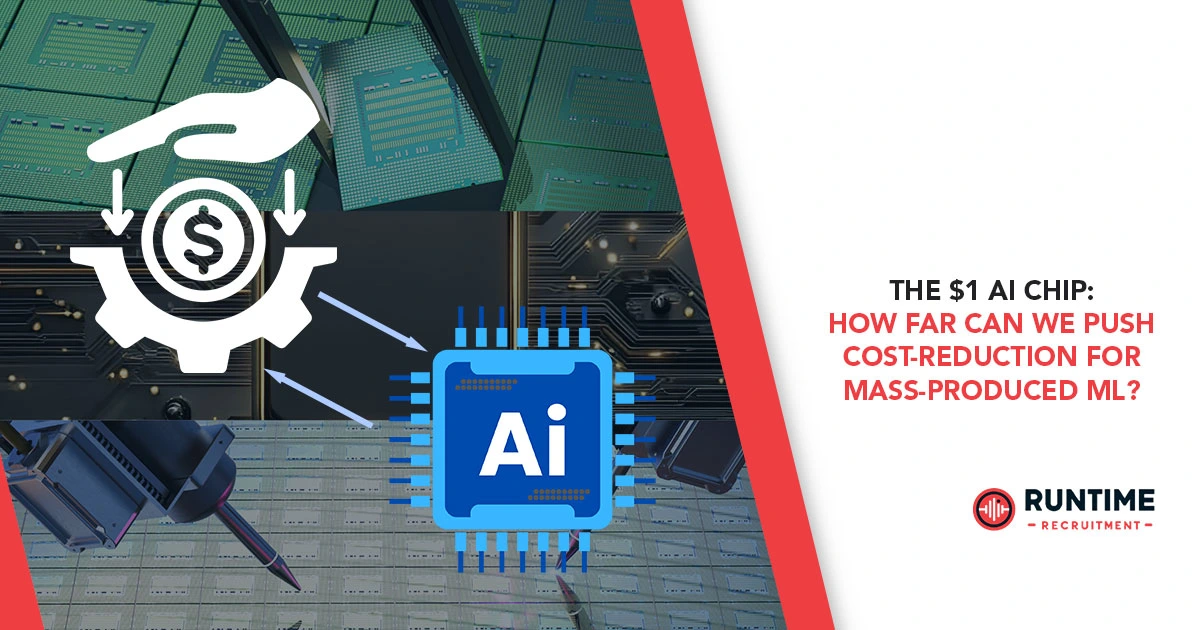The promise of Artificial Intelligence (AI) has permeated nearly every industry, from sophisticated data centers to the most mundane household appliances. Yet, for many mass-produced applications, the cost of implementing AI, particularly the underlying hardware, remains a significant barrier. We’re not talking about server-grade GPUs here; we’re talking about ubiquitous, everyday devices where every cent counts. This article delves into the fascinating and challenging world of sub-dollar AI chips, exploring the current landscape, the technological hurdles, and the immense potential of truly democratized machine learning.
The notion of a “$1 AI chip” might seem like science fiction to some, especially those accustomed to multi-dollar microcontrollers or even higher-priced specialized AI accelerators. However, the relentless march of semiconductor manufacturing, coupled with innovative design paradigms, is making this a tangible, albeit ambitious, goal. For embedded engineers, this isn’t just an academic exercise; it’s a profound shift that could unlock a tidal wave of new products and capabilities, bringing intelligent features to everything from disposable medical sensors to smart packaging.
The Driving Force: Why $1 Matters
Why is reaching the $1 price point so critical? The answer lies in market dynamics and the sheer scale of potential applications. Consider the following:
- Mass Market Adoption: For consumer electronics, white goods, and many IoT devices, bill-of-materials (BOM) cost is king. A $5 component might be acceptable in a high-end smartphone, but it’s a non-starter for a smart light bulb or a basic sensor node. Dropping the AI processing cost to $1 or below opens up markets previously unattainable.
- Disposable Electronics: Imagine smart labels for perishable goods that can detect spoilage, or single-use medical diagnostic devices with on-chip inference. These applications demand extreme cost-efficiency.
- Edge Intelligence Everywhere: The vision of truly pervasive AI relies on distributing intelligence widely, moving away from centralized cloud processing. This “edge AI” necessitates low-cost, low-power inference engines at the very periphery of the network.
- Sustainable Innovation: Lowering hardware costs democratizes AI development, allowing smaller companies and innovators to experiment and bring intelligent products to market without massive upfront investment in specialized silicon.
The Current Landscape: Early Contenders and Approaches
While a true $1 AI chip might still be an aspiration for many, several companies are actively pursuing highly cost-optimized solutions. These typically fall into a few categories:
- Ultra-Low-Power Microcontrollers with ML Capabilities: Many mainstream MCU vendors are integrating specialized instructions or even small hardware accelerators for machine learning inference into their existing microcontroller architectures. These are often optimized for tinyML applications, running lightweight neural networks for tasks like keyword spotting, anomaly detection, or simple classification. The cost here leverages existing MCU platforms and high-volume production.
- Application-Specific Integrated Circuits (ASICs) for Specific ML Tasks: For highly specific, high-volume applications, a custom ASIC can offer unparalleled cost and power efficiency. If you know precisely what model you need to run and the required performance, an ASIC can be designed to do just that, stripping away any unnecessary general-purpose capabilities. The NRE (Non-Recurring Engineering) cost for ASICs is high, but amortized over millions of units, the per-chip cost can drop dramatically.
- FPGA-based Solutions (for Niche/Lower Volume): While generally not hitting the $1 mark, tiny FPGAs are becoming more power-efficient and cost-effective, offering programmability for specific ML accelerators where volumes don’t justify a full ASIC, but flexibility is still required. These bridge the gap between fixed-function ASICs and general-purpose MCUs.
Examples of commercially available silicon pushing the boundaries include some ARM Cortex-M based MCUs with DSP extensions, specialized ML cores (like Ethos-U), or even RISC-V based solutions designed with ML in mind from the ground up. The key is extreme optimization for inference rather than training, which is far more computationally intensive.
The Technical Hurdles: Making Every Transistor Count
Achieving the $1 price point for an AI chip involves overcoming formidable technical challenges across multiple domains:
1. Silicon Area and Process Node: The Fundamental Cost Driver
The primary driver of semiconductor cost is silicon die area. Smaller dies mean more chips per wafer, which directly translates to lower per-chip cost.
This pushes designers towards:
- Minimalist Architectures: Stripping down the core IP to only what’s absolutely essential for the target ML task. This means very small memory footprints, limited I/O, and highly specialized compute units.
- Mature Process Nodes: While cutting-edge nodes (e.g., 7nm, 5nm) offer performance and power benefits, they are significantly more expensive. For sub-$1 chips, older, well-understood, and highly depreciated process nodes (e.g., 55nm, 40nm, 28nm) are often preferred. These nodes have fully amortized R&D and manufacturing costs, leading to much lower per-wafer costs.
- Extreme Integration: Integrating as many functions as possible onto a single die (processor, memory, limited peripherals, power management) to reduce board-level component count and assembly costs.
2. Architecture and Instruction Set Design: Maximizing Efficiency
The choice of instruction set architecture (ISA) and the overall microarchitecture plays a crucial role:
- RISC-V’s Rise: The open-source RISC-V ISA is gaining traction for ultra-low-cost, custom silicon. Its modularity allows designers to select only the necessary extensions, leading to incredibly compact core implementations. Moreover, the lack of licensing fees significantly reduces overall cost.
- Specialized Accelerators: General-purpose CPUs are inefficient for matrix multiplications, the bedrock of neural networks. Dedicated hardware accelerators for MAC (Multiply-Accumulate) operations, convolutional layers, and activation functions are vital. These can be tiny, highly parallel arrays designed for fixed-point or even binary neural networks.
- Data Type Optimization: Moving away from floating-point arithmetic to 8-bit integer (INT8), 4-bit integer (INT4), or even binary (1-bit) data types significantly reduces computational complexity, memory bandwidth, and storage requirements. This requires careful quantization of pre-trained models.
3. Memory Subsystem: A Major Bottleneck
Memory is often the most expensive component in terms of silicon area and power consumption.
- On-Chip SRAM: Maximizing the use of tiny, fast on-chip SRAM for model weights and activations minimizes external memory access, which is slow and power-hungry. The challenge is fitting a useful model into a few kilobytes of SRAM.
- In-Memory Computing (IMC) / Near-Memory Computing (NMC): Emerging architectures that perform computations directly within or very close to memory arrays hold immense promise for energy and area efficiency. While still nascent for mass production, these could be game-changers for ultra-low-cost AI.
- Sparsity Exploitation: Many neural networks are “sparse,” meaning many weights are zero or close to zero. Architectures that can efficiently skip these operations reduce computational load and memory accesses.
4. Power Management: A Universal Constraint
Battery-powered edge devices demand extremely low power consumption.
- Aggressive Clock Gating and Power Gating: Switching off parts of the chip when not in use is fundamental.
- Voltage Scaling: Operating at the lowest possible voltage to maintain functionality dramatically reduces power.
- Ultra-Efficient Design: Every circuit block must be designed with power consumption as a primary metric.
5. Software and Toolchain: The Ecosystem Challenge
Hardware alone isn’t enough; a robust software ecosystem is essential for widespread adoption.
- TinyML Frameworks: Tools like TensorFlow Lite Micro are specifically designed to deploy highly optimized models onto resource-constrained devices.
- Quantization Tools: Automated and semi-automated tools to quantize models from floating-point to integer representations are critical for usability.
- Compiler Optimization: Compilers specifically tailored to the target hardware architecture can extract maximum performance and efficiency.
The Path Forward: Innovation and Collaboration
The journey to the $1 AI chip is not just about incremental improvements; it requires disruptive innovation and close collaboration across the industry.
- Novel Materials and Packaging: Beyond traditional silicon, researchers are exploring new materials and advanced packaging techniques that could further reduce cost and improve integration.
- Open-Source Hardware: Just as RISC-V has democratized ISAs, open-source hardware designs for ML accelerators could accelerate innovation and drive down costs by fostering community contributions and shared IP.
- AI for AI Chip Design: AI itself can be used to optimize chip designs, exploring vast design spaces more efficiently than human engineers, potentially leading to unforeseen cost reductions.
- Model Compression and Optimization: Ongoing research in neural network compression techniques (pruning, quantization, knowledge distillation) is crucial. Smaller, more efficient models require less powerful and less expensive hardware. This is a co-design problem: hardware informs model design, and vice-versa.
- Hybrid Approaches: Combining the best of both worlds – a tiny, ultra-efficient custom accelerator for the core ML task, coupled with a minimal, low-power general-purpose MCU for control and I/O.
The Impact: A Glimpse into the Future
Imagine a world where:
- Every light switch is a smart sensor: Recognizing activity patterns, presence, and even identifying individuals without cloud connectivity.
- Smart packaging prevents food waste: Labels that monitor freshness and alert consumers, or even trigger chemical changes to extend shelf life.
- Wearable health monitors are ubiquitous and disposable: Tiny patches that continuously monitor vital signs, detect anomalies, and predict health issues, at a cost that makes them accessible to everyone.
- Industrial sensors perform predictive maintenance on the edge: Detecting subtle anomalies in machinery long before failure, preventing costly downtime.
- Agricultural sensors optimize crop yields: Individual plant monitoring for water, nutrient, and pest stress, leading to more efficient resource use.
These are just a few examples. The $1 AI chip isn’t just about making existing products cheaper; it’s about enabling an entirely new class of intelligent, pervasive devices that were previously economically unfeasible. It democratizes AI, moving it from the data center to the hands of billions, embedding intelligence into the very fabric of our environment.
Conclusion: The Race to the Bottom, or the Race to Ubiquity?
The pursuit of the $1 AI chip is a fascinating convergence of economic imperatives and engineering ingenuity. It demands a holistic approach, from process technology and architectural innovation to software optimization and novel model compression techniques. While challenging, the rewards are immense: an explosion of intelligent devices, a truly pervasive AI landscape, and a future where machine learning augments every aspect of our lives in a sustainable and cost-effective manner.
The embedded systems community stands at the forefront of this revolution. Your expertise in squeezing maximum performance from minimal resources, optimizing power consumption, and navigating the complexities of real-world deployments is precisely what’s needed to make the $1 AI chip a reality. This isn’t just a race to the bottom in terms of cost; it’s a race to unlock unprecedented levels of intelligence at the very edge of the network, transforming industries and improving lives globally. The future of mass-produced ML is not just about powerful algorithms, but about accessible hardware that can bring those algorithms to every corner of our world.
Ready to shape the future of embedded AI?
Connect with RunTime Recruitment today. We specialize in placing top-tier embedded engineers in roles that are pushing the boundaries of what’s possible in cost-optimized, mass-produced machine learning. Your next groundbreaking project awaits!









